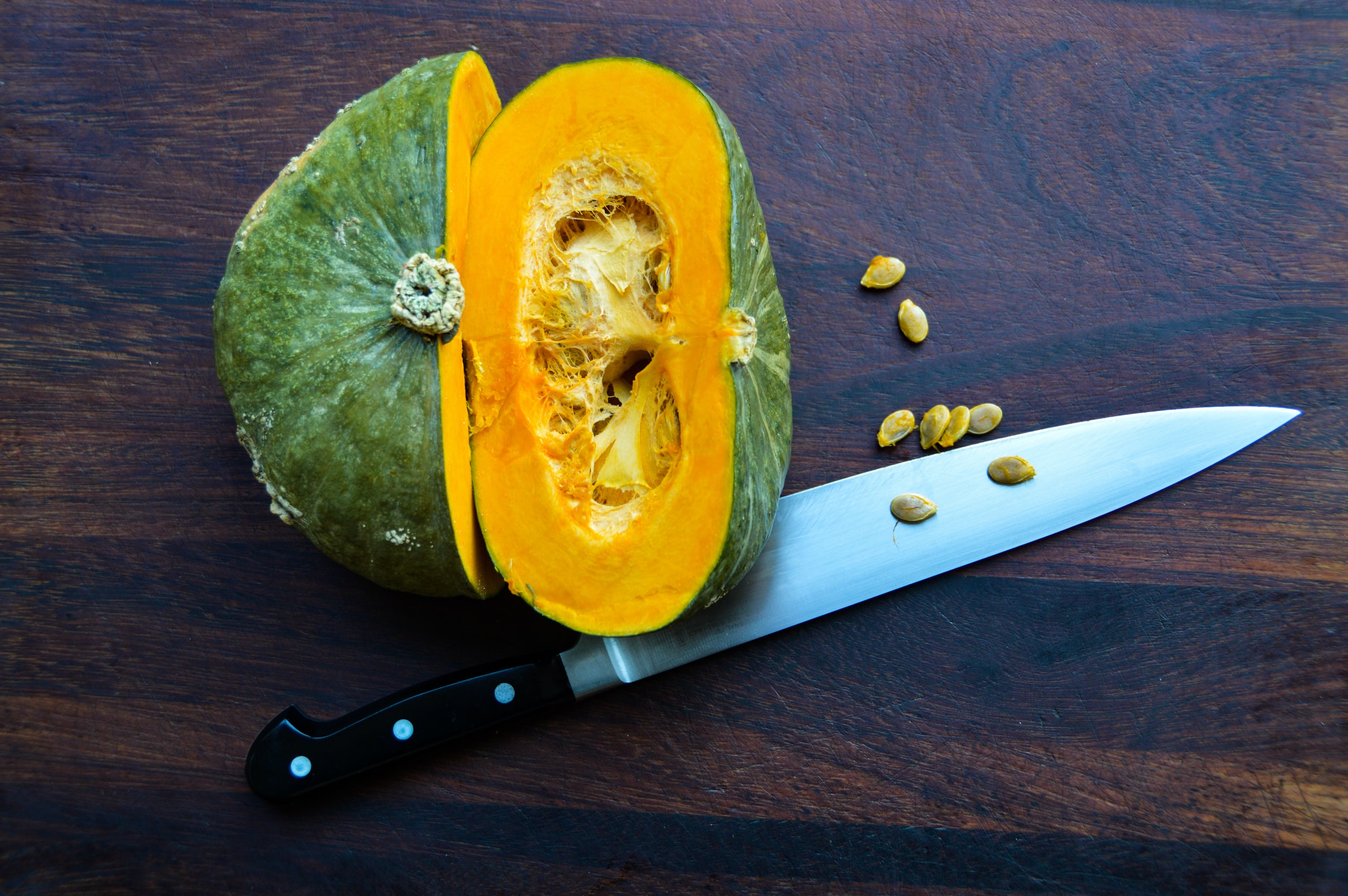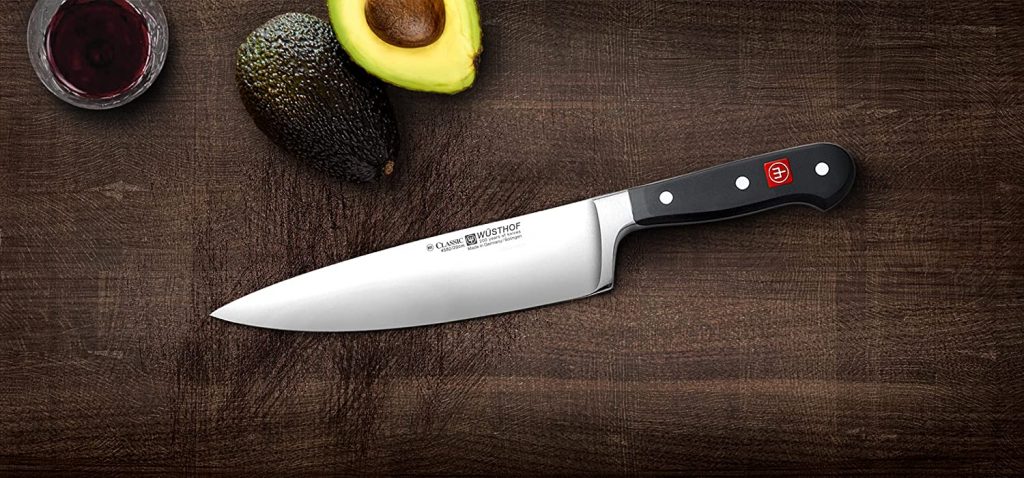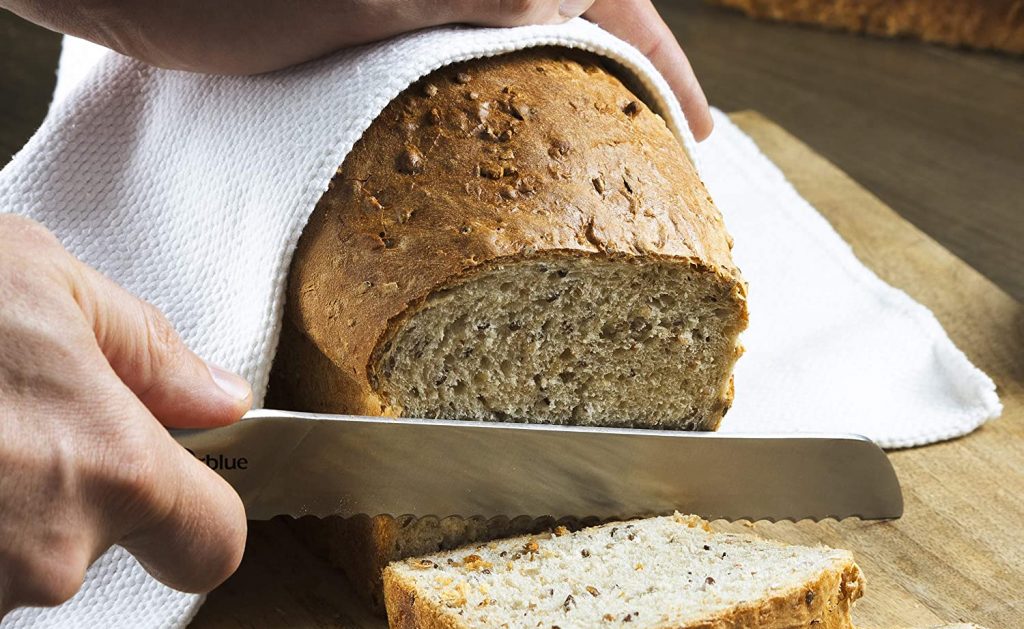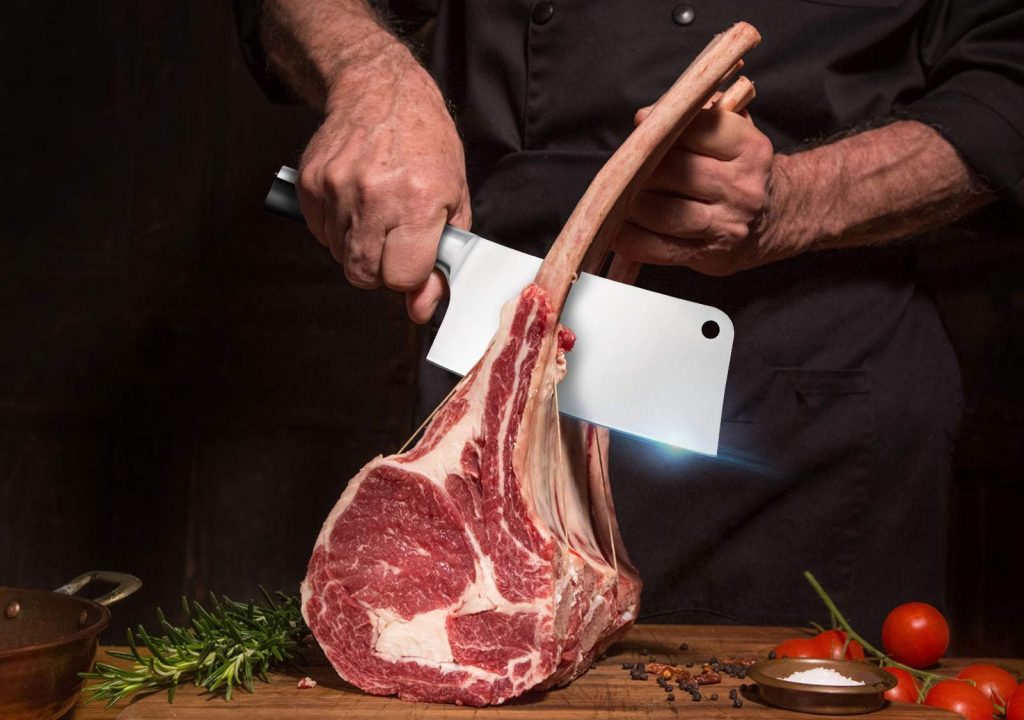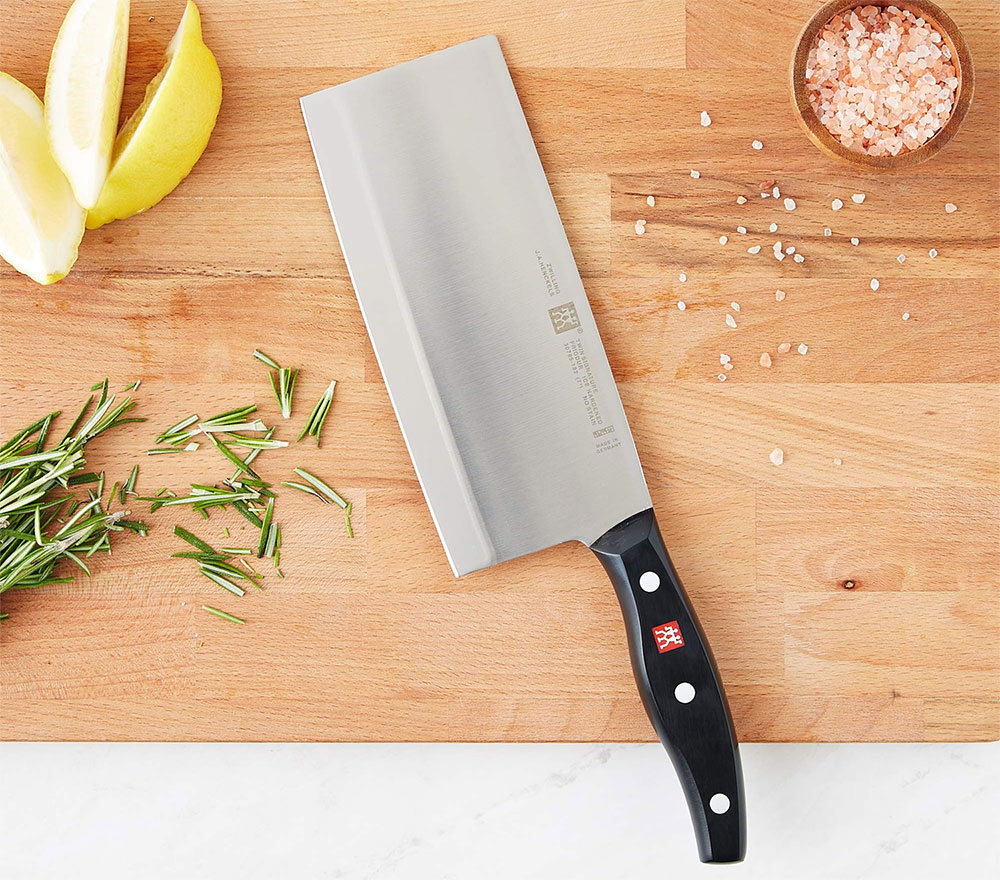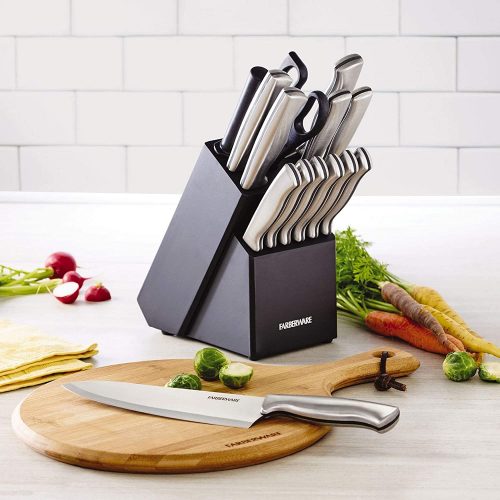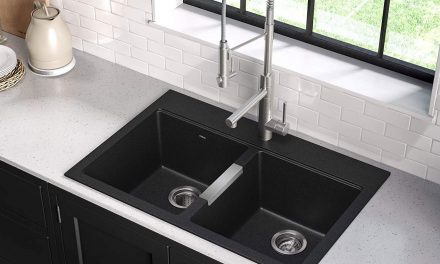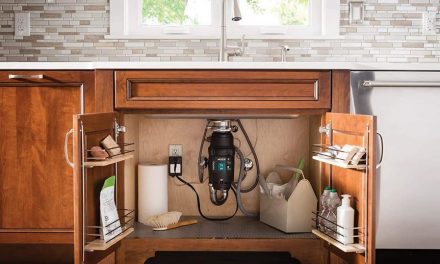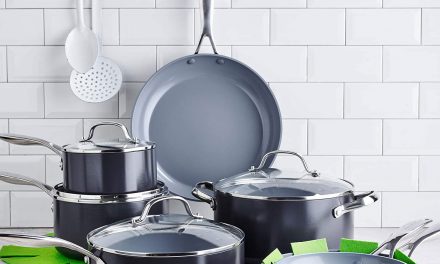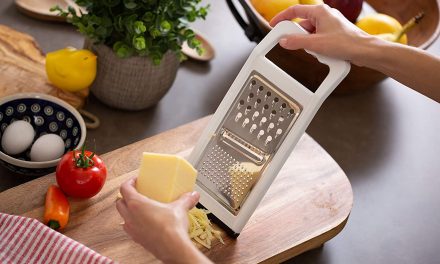There are few tools used more in a kitchen than a knife, but it’s easy to find yourself overwhelmed by choice when you get ready to buy one. This guide will help you learn what goes into a good kitchen knife, what to look for in manufacturing styles, which knives are used for what, and which brands are some of the most respected in the business.
Types of kitchen knives
There are many types of knives available on the market—and many confusing and interchangeable terms to go with them! Below you’ll find a list of the most useful kitchen knives.
Chef’s knives
With a blade that is typically 8 inches long, the standard chef’s knife is actually smaller than what most professional chefs use (knives that are 9-12 inches long), but it’s still the most versatile of the kitchen knives. Good for slicing, dicing, and chopping, there’s little the chef’s knife can’t do. However, as general purpose knives, their one drawback is they’re not necessarily the best knife for a lot of tasks.
Looking to forgo knife sets in favor of one or two high-quality multipurpose knives? The chef’s knife is one you’ll definitely want to buy. If the standard 8-inch length seems too big and unwieldy to you, don’t fret. There are 6-inch and 7-inch chef’s knives or utility knives, as well. These shorter knives offer better control, especially for those with small hands.
Utility knives, paring knives, and petty knives
Maybe you’ve already got a chef’s knife and are wondering what to buy next. In that case, consider a smaller knife that will give you better control and precision.
With blades that are usually around 2.5-4 inches in length, paring knives are much smaller than the standard 8-inch chef’s knife. These knives are great for mincing garlic, slicing or deseeding small fruits, or peeling vegetables you’re holding in your hand. Some paring knives also sport curved blades, sometimes called “bird’s beaks,” which can be useful for working with small, round vegetables.

Paring knife examples, featuring KitchenAid’s triple rivet paring knife, Kessaku’s bird’s beak paring knife, and Kuhn Rikon’s yellow paring knife from its 3-knife set.
Similar to paring knives are petty knives and utility knives, both of which typically have slightly longer blades than paring knives do.

A look at how similar petty knives and utility knives often are. Many sellers use the words interchangeably. Featuring Yoshihiro’s stainless steel petty knife (left) and Paudin’s utility knife (right).
When it comes to blade length, there’s a lot of overlap between paring knives, utility knives, petty knives, and even shorter chef’s knives, but in general paring knives will be the smallest of these. If you’re looking for something smaller than a standard chef’s knife for general purpose tasks, stick with utility and petty knives. If you’re looking for precision, look for paring knives.
Bottom line? Get the blade lengths that will work best for your hand size and shape.
Serrated knives
Any size blade can be serrated, but knowing what serration is typically used for will help you decide if a serrated knife is right for your kitchen and, if so, what length blade to buy.
Serration is best for cutting into softer or more delicate foods that might be torn or crushed by a standard blade—think breads, tomatoes, chocolates, etc. Technically, your chef’s knife will cut soft foods just fine if you keep it sharp enough, but, hey, you’re only human and probably not a chef, in which case a serrated knife will pick up the slack. You’ll probably get the most use out of a bread knife.
What about serrated steak knives? While common in households, you may have noticed before that you don’t always get a serrated blade at a nice steakhouse. This is largely because serrated blades are more difficult to sharpen. Whether you want serrated steak knives or not, know this may be a blade type you occasionally replace over time. You may not want to spend a lot on it.
Slicing and carving knives
Slicing and carving knives are thin, ridged, and long, with blades that are usually 10-14 inches in length. They’re ideal for cutting thin slices of meat.
What’s the difference between a slicing knife and a carving knife? Usually the tip and the thickness of the blade. Slicing knives tend to be thinner and have a rounded tip, while carving knives tend to be thicker and have a pointed tip. The thicker blade and pointier tip of a carving knife is better suited to cutting through poultry and some meats that still have the bone in.
Don’t be surprised if you see stores and knife manufacturers use these two terms interchangeably.

See Victorinox’s 12-inch slicing knife, with its rounded tip, vs. Mercer Culinary’s 10-inch carving knife, which has a pointed tip.
Cleavers
There’s a reason most knife sets don’t come with a cleaver: you probably won’t need one. These larger, rectangular kitchen knives are suited for cutting into stubborn and unprocessed meats and for quickly chopping vegetables.
Heavier cleavers are meat cleavers that assist with the toughest kitchen job one may do: the cutting of bone and thick tendon. They’re primarily used by butchers.
Vegetable cleavers are lightweight. Meant specifically for fast-chopping vegetables, they are not a general purpose knife and are mostly seen in some professional kitchens. Their thin blade and narrow, sharp edge make them best suited for chopping soft vegetables, such as peppers and tomatoes. Somewhat delicate, they’re not even intended for tougher vegetables, like root vegetables or squashes.
Other specialty knives
These knives and scissors are so specialized that they have no place in the standard kitchen. However, maybe your kitchen isn’t so standard! If you eat lots of fish or have some specific herb and vegetable needs, a few specialty knives might be useful to you.
- Boning knives: Used for deboning poultry
- Filleting knives: Used for deboning fish; more flexible than a boning knife
- Salmon knives: Used for slicing fish
- Tomato knife: Used specifically for tomatoes, often serrated
- Kitchen shears: Not a knife, but often found in sets; used for light tasks, like trimming herbs or asparagus, or difficult tasks, like cutting through poultry
The most respected kitchen knife brands
There are countless kitchen knife-makers in the market, with most based partially or fully in China. Does that mean off-brand knives aren’t good? No, not at all. But it does mean the maker is likely newer to the skill and market and may not be as good about honoring warranties when defects or issues arise.
Below you’ll find a list of well-known and respected kitchen knife brands. While not a comprehensive list, these are the brands you’re most likely to encounter, and the ones that regularly appear in chefs’ “best of” lists.
MAC
The Japanese MAC Knife company’s claim is that they make “the world’s sharpest knives,” and many casual and professional reviewers agree. They’re also known for crossover knives that include characteristics seen in both Japanese and German/Western knife-making. Heads up when buying MAC knives on Amazon: they only honor warranties from purchases made through authorized sellers.
Mercer Culinary
Compared to other brands, Mercer Culinary is a new kid on the block, but it’s well-respected and their knives are used by professional chefs. The company is a little secretive on their website about where their knives are manufactured, but most on the market appear to be made in Taiwan using German steel.
Misono
This Japanese knife manufacturer has been around since 1935, but didn’t begin manufacturing knives until the 1960s. They are the oldest Japanese knife maker that specifically creates knives in the Western style. Made in Japan, they often make use of Swedish steel.
Victorinox
You know this maker from Swiss Army knives. Founded in 1884 in Switzerland, they’ve been in the business for a long time. Genuine Victorinox blades are still made in Switzerland, using a steel blend that’s sourced from Germany and France.
Wüstof
This German maker has been in the steel and knife-making business for 200 years. Professional chefs and review magazines, like Consumer Reports, often consider their knives some of the best in the market. Genuine Wüsthof knives are manufactured in Solingen, Germany.
Zwilling J.A. Henckles
When a company manages to stick around for nearly 300 years, they must be doing something right. Like Wüsthof knives, Zwilling J.A. Henckels knives are manufactured in Solingen, Germany.
How to know if a kitchen knife is good
Kitchen knives may seem simple on their face, but much goes into their construction. From the materials used to the physical characteristics of both handle and blade, there’s a lot you can choose from when it comes to a kitchen knife—if you want to go to the trouble.
There’s some truth to “you get what you pay for,” but only up to a certain point. In general, though, expect to pay $50-$100 for a good knife. Below this amount, you’re more likely to encounter flaws in the steel. Above this amount, the benefits may not be noticeable to the average home cook.
If you’re wanting to get into the finer details, keep reading!
Are kitchen knife sets good?
Multi-piece kitchen knife block sets can cost as little as $20 and go up to well over $150. The better sets can be a good deal for the average home kitchen. They won’t slice or chop as nicely as better-made knives manufactured with dedicated tasks in mind, but they’ll get most jobs done for most people.
If you’re looking for some middle ground, consider getting a basic knife set and one to two nicer knives for general or single purposes. Keep reading to learn which specialty knives are most useful.
Stainless steel vs. carbon steel
In the kitchen knife market, you’ll frequently see mention of German and Japanese steel. This doesn’t have anything to do with quality. While this can refer to where the blades are manufactured or where the metal is sourced, this may also refer to the origin of the style, which tends to dictate blade shape, point, and beveling. There are also “Western-style Japanese” blades. These are blades that combine characteristics seen in both German/Western and Japanese styles.
Either of these blade styles will almost universally be made from two types of steel: carbon steel or stainless steel. Carbon steel is an alloy of iron and carbon, while stainless steel is made up of iron, carbon, and chromium. Minimal amounts of other metals or minerals may be present in either. Both types are good for kitchen knives, and both come with their share of pros and cons.
Without the added chromium, carbon steel is a harder metal. This makes it easier to sharpen and better at retaining its sharpness, but it also means it’s more brittle and could chip over time or if you drop it on the floor. Stainless steel is softer, and so more prone to warping and dulling, but it has its own strengths. In particular, stainless steel is highly rust resistant compared to carbon steel, which is reactive and fussier when it comes to cleaning and care.
As carbon steel comes into contact with acidic foods, it will oxidize, causing stains and a greenish-brown discoloration called patina. Similarly, if carbon steel is not carefully dried after cleaning it can rust. Rubbing the blade down with mineral oil will help prevent rusting, but it is also another task to complete in your cleaning process.
So how are you supposed to choose between these two types of steel? Consider the following:
- Dishwashing: It’s best to clean knives by hand, but if you’re not going to do that, be honest with yourself and go with a stainless steel knife. The chromium coating protects it in the wet environment of the dishwasher. Stainless steel isn’t rust-proof, but it is rust-resistant.
- Care & Maintenance: Carbon steel requires more care overall, but you won’t have to sharpen it as often as stainless steel. Bottom line? Pick which chore you hate the least and go with the associated blade.
- Aesthetics: Related to the two points above is the matter of staining. If you like the idea of a blade with character, go with carbon steel and watch it change with time and use. If the sight of stains and discoloration make you obsess over potential uncleanliness, stick with stainless steel.
Wondering what professional chefs use?
They tend to prefer carbon steel knives, and not just any carbon steel: _high_-carbon steel. This is what it sounds like, a steel alloy that contains more carbon in it. High-carbon knives can have as much as 2% of their weight dedicated to carbon, and they’re only allowed minimal amounts of manganese and copper in the alloy.
Handles: materials and hidden-tang vs. full-tang
Kitchen knife handles are constructed from a number of different plastics and woods. Plastics are less finicky about getting wet and being exposed to heat; they’re also less likely to harbor bacteria. Wood handles shouldn’t be subjected to dishwashers, and when washed by hand, they should be dried as soon as possible.
Then there’s the tang. A blade obviously isn’t just glued to its handle. It extends into the handle. This part of the blade is what’s known as the tang. There are two types of tang: hidden-tang and full-tang.
Hidden-tang knives have a tang that extends only partially into the handle. Where it extends to is thought to be where the typical user will apply the most pressure to the knife. The handle hides the tang, thus the name.

See Victorinox’s 8-inch chef’s knife, which has a hidden tang.
Full-tang knives have a tang that visibly extends the full length of the handle.

See Wüstof’s 6-inch utility knife with its full-tang.
Both tang types can be great for general purposes, but if you care about durability, you might lean more toward a full-tang. The handle is less likely to come apart from the blade, no matter how much you abuse it over the years.
Tip: Most general purpose knives are made for lefties and righties alike, but a few have handles which are better suited (typically) for right-handed users. If you’re left-handed, this is something you’ll want to watch out for.
Size, shape, and thickness
Materials aren’t all that matter when choosing kitchen knives. The way a blade is constructed in terms of its size, shape, and thickness also matters, and greatly determines how you’ll naturally use the knife and what you can realistically do with it.
In professional kitchens, chefs often opt for larger knives that are 9-12 inches long. This is so they can slice or chop through more food at once on a cutting board. These large knives can be heavy and unwieldy for the average user with a compact kitchen, however. A 6- or 8-inch chef’s knife will work well for most purposes.
When a blade’s sharp edge is shaped in a way that is very straight and flat, it’s ideal for up-and-down and back-and-forth movements, making it great for slicing. A rounded edge is ideal for cutting that employs a rocking motion; in some ways this has a more general purpose. Japanese kitchen knives often have straighter edges, while German kitchen knives are more likely to have rounded edges.
If you’re looking for a knife that can be used for lots of different purposes, find one with a thin blade and a double bevel.
The thin blade will cut through most foods, and quickly—until you get to the thick, tough stuff, like bones in meat. That’s where you’ll need the weight of a thicker blade. The downside to a thicker blade is also its upside: it is heavier. If you’re planning to slice or chop many things in the kitchen, a heavy blade can become cumbersome.
Lefties, watch out for beveling
Beveling is the other area where lefties might get into trouble. Most blades are double beveled in some way, so it’s easy to forget beveling actually impacts use and experience. A single-beveled blade is great for something like sashimi, but it has narrower uses and several quirks that take some getting used to. Keeping your slices straight is more difficult with a single bevel, and these knives are more difficult to sharpen.
The biggest beveling difference of all is that the handle and forging of single-bevel knives come with an element of handedness. When cutting with a single-bevel knife, the beveled side should be on the side of the blade that corresponds with the user’s handedness, meaning single-bevel knives are actually constructed in a way that is meant for either right- or left-handed users. Right-handed users should see a single bevel on the right side of the blade, while left-handed users should see their single bevel on the left side.
It’ll come as no surprise to lefties that there are more single-bevel knives for right-handed users than left-handed ones.
How to use a knife
In some cases, it really is in the way that you use it. Holding a knife the wrong way will slow you down in the kitchen, and it can even make you more prone to harmful accidents. Check out this video to learn about the different ways to hold a knife when performing various cutting and slicing tasks.
Cleaning and sharpening kitchen knives
No matter what you spend on a knife, it will only retain its quality if you care for it properly. Make sure to wash and dry your knives properly, and remember that a dull knife is a dangerous knife.
There are a couple of different ways to sharpen a knife. Professionals make use of a honing steel and a whetstone. The honing steel straightens the steel of your knife, which naturally warps and bends over time with use. The whetstone is what sharpens the steel. There are also easy-to-use knife sharpening tools, which are great for the home.
Kitchen knife starter kit
Looking for the best kitchen knives that will require little in the way of maintenance and care?
- Find an average-sized (~8-inch), stainless steel, double-bevel chef’s knife with a plastic handle. Victorinox’s will be a good fit. This type of knife is likely to be the best, all-around knife for the typical home kitchen and user who doesn’t want to bother with a lot of care.
- Get a bread knife, like Mercer Culinary’s 8-inch wavy edge bread knife.
- Buy a paring knife, like Zwilling J.A. Henckels’ 4-inch paring knife, for when you need to cut things more precisely.

